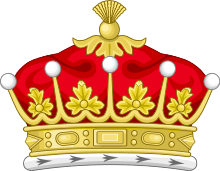Earl of Lisburne
| Earldom of Lisburne | |
|---|---|
|
Arms of the Earls of Lisburne: Sable, a chevron between three fleurs-de-lis argent [1] | |
| Creation date | 1776 |
| Monarch | George III |
| Peerage | Peerage of Ireland |
| First holder | Wilmot Vaughan, 4th Viscount Lisburne |
| Present holder | David Vaughan, 9th Earl of Lisburne |
| Heir presumptive | Hon. Michael Vaughan |
| Subsidiary titles |
Viscount Lisburne Baron Fethard |
| Former seat(s) |
Trawsgoed Mamhead Park |
Earl of Lisburne is a title in the Peerage of Ireland. It was created in 1776 for Wilmot Vaughan, 4th Viscount Lisburne. He represented Cardiganshire and Berwick-upon-Tweed in the House of Commons and held minor governmental office.[2]
Not satisfied with the Irish title, Lisburne attempted to cajole his way into a title in the Peerage of England through his support of the Prime Minister the Duke of Portland. He quite unsuccessfully suggested in a letter that he would withdraw his support if he did not receive a peerage; Lisburne was horrified when his threat reached the ears of the king. "... his Majesty observed upon it that he could not have supposed that Lord Lisburne would have imagined that he was to be frightened into giving peerages—the moment was not open for explanation—your opinion, the declaration of your intentions, was in writing."[2]
His younger son, the third Earl, sat as Member of Parliament for Cardigan. He was succeeded by his son, the fourth Earl. He also represented Cardiganshire in Parliament.[1] His great-grandson, the seventh Earl, served as Lord Lieutenant of Cardiganshire. As of 2015 the titles are held by the latter's grandson, the ninth Earl, who succeeded in 2014.[3]
The titles of Baron Fethard (or Baron Fethers), of Feathered in the County of Tipperary, and Viscount Lisburne, were created in the Peerage of Ireland in 1695 for John Vaughan, Member of Parliament for Cardiganshire and also Lord Lieutenant of that county. His son, the second Viscount, also represented Cardiganshire in Parliament and was Lord-Lieutenant of Cardiganshire. His younger brother, the third Viscount, was he too Lord Lieutenant of Cardiganshire. He was succeeded by his son, the aforementioned fourth Viscount, who was created Earl of Lisburne in 1776.[4]
The heir apparent to the earldom uses the invented courtesy title Viscount Vaughan.
The family seat traditionally was Trawsgoed (Crosswood) in Ceredigion (Cardiganshire), Wales.[5]
Viscounts Lisburne (1695)
- John Vaughan, 1st Viscount Lisburne (1670–1721)
- John Vaughan, 2nd Viscount Lisburne (1695–1741)
- Wilmot Vaughan, 3rd Viscount Lisburne (died 1766)
- Wilmot Vaughan, 4th Viscount Lisburne (1730–1800; created Earl of Lisburne in 1776)
Earls of Lisburne (1776)
- Wilmot Vaughan, 1st Earl of Lisburne (1730–1800)
- Wilmot Vaughan, 2nd Earl of Lisburne (1755–1820)
- John Vaughan, 3rd Earl of Lisburne (1769–1831)
- Ernest Augustus Mallet Vaughan, 4th Earl of Lisburne (1800–1873)
- Ernest Augustus Malet Vaughan, 5th Earl of Lisburne (1836–1888)
- George Henry Arthur Vaughan, 6th Earl of Lisburne (1862–1899)
- Ernest Edmund Henry Malet Vaughan, 7th Earl of Lisburne (1892–1963)
- John David Malet Vaughan, 8th Earl of Lisburne (1918–2014)
- David John Francis Malet Vaughan, 9th Earl of Lisburne (born 1945)
The heir presumptive is the current holder's brother, the Hon. Michael John Wilmot Vaughan (born 1948).
See also
References
- 1 2 Debrett, John (1847). Debrett's Genealogical Peerage of Great Britain and Ireland. p. 472. Retrieved 7 October 2015.
- 1 2 "VAUGHAN, Wilmot, 1st Earl of Lisburne [I] (1728-1800), of Crosswood, Card". History of Parliament Online. The History of Parliament Trust. Retrieved 7 October 2015.
- ↑ "The Earl of Lisburne - obituary". The Daily Telegraph. 17 November 2014. Retrieved 7 October 2015.
- ↑ Debrett, John (1820). Debrett's Peerage of England, Scotland, and Ireland. p. 992. Retrieved 7 October 2015.
- ↑ Aslet, Clive (29 December 2007). "Village voice: Trawsgoed". The Daily Telegraph. Retrieved 7 October 2015.
- Kidd, Charles, Williamson, David (editors). Debrett's Peerage and Baronetage (1990 edition). New York: St Martin's Press, 1990

